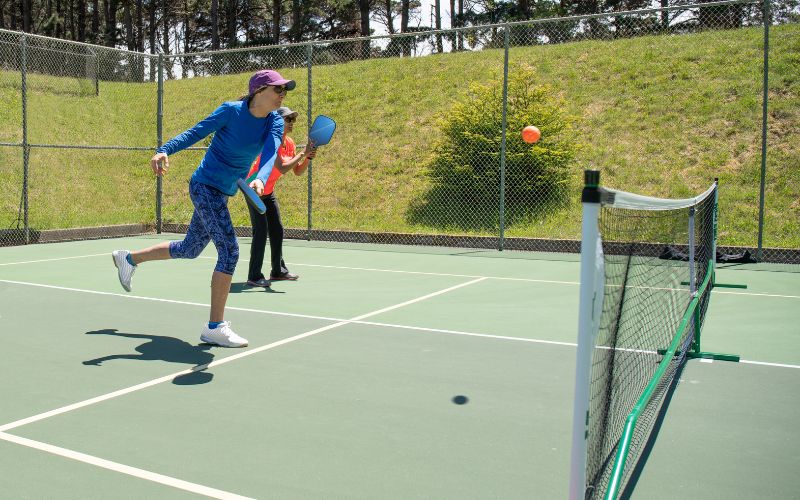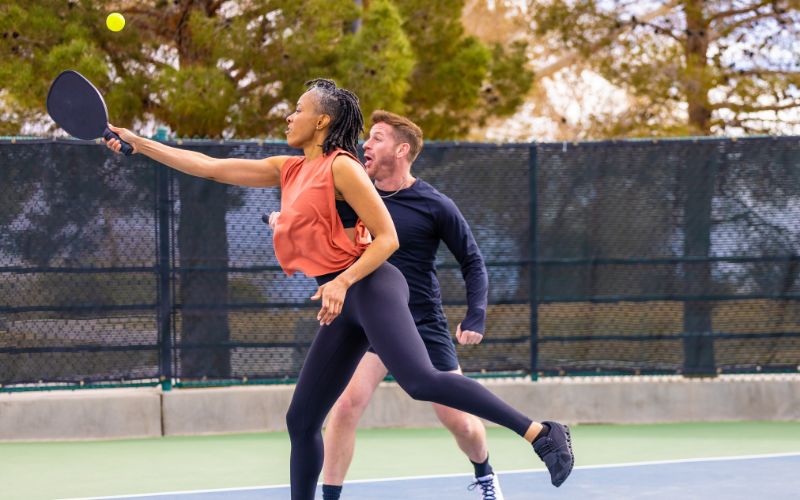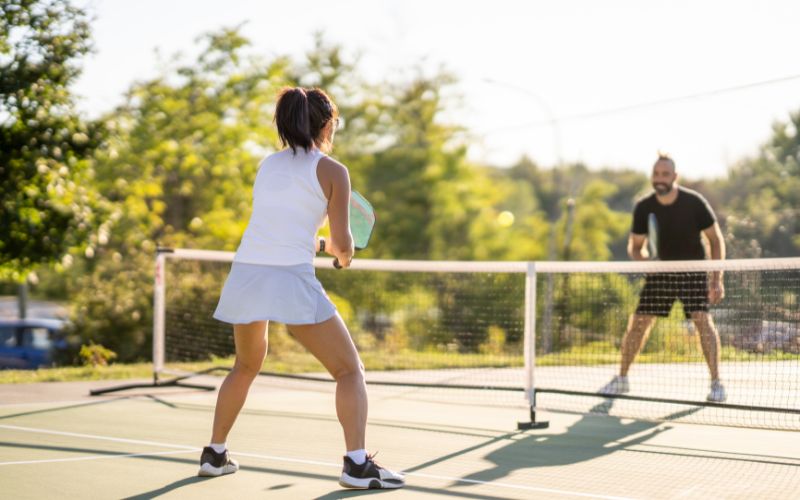Pickleball is a rapidly growing sport that combines elements of tennis, badminton, and ping pong. As with any sport, repetitive motions and improper techniques can lead to injuries. One of the most common injuries among pickleball players is “Pickleball Elbow.” In this article, we’ll delve deep into understanding the causes and symptoms of this condition.
What is Pickleball Elbow?
Pickleball elbow is a form of tendinitis that affects the tendons in the elbow. It’s caused by repetitive stress on the elbow joint, particularly when playing pickleball. The condition is similar to tennis elbow, but it’s specific to the movements and stresses associated with pickleball.
Causes of Pickleball Elbow
Pickleball, a sport that combines elements of tennis, badminton, and ping pong, has gained immense popularity over the years. However, with its rise in popularity, there’s been an increase in a specific type of elbow injury known as “Pickleball Elbow.” Understanding the causes can help players prevent and manage this condition more effectively.
1. Overuse of Forearm Muscles
The repetitive motion of swinging the paddle in pickleball can strain the forearm muscles. Over time, continuous play without adequate rest can lead to microtears in the tendons that attach these muscles to the lateral epicondyle, the bony bump on the outer part of the elbow. This overuse is a primary cause of pickleball elbow injury.
2. Lateral Epicondylitis
Commonly known as “tennis elbow,” lateral epicondylitis is an inflammation of the tendons that join the forearm muscles to the outside of the elbow. While lateral epicondylitis is named after tennis, pickleball players are also at risk. The repetitive motions in both sports can strain the elbow tendons, leading to this condition.
3. Improper Technique
Using incorrect swing techniques or grip can place additional stress on the forearm muscles and tendons. Players who do not use their whole arm to swing or grip the paddle too tightly might be more prone to develop tennis elbow or its pickleball counterpart.
4. Previous Injuries
Players who have had a previous injury are at a higher risk of developing pickleball elbow. Past injuries might have weakened the tendons or muscles, making them more susceptible to strain during play.
5. Equipment Issues
Using a paddle that’s too heavy or with an inappropriate grip size can exacerbate the strain on the forearm muscles. It’s crucial to select equipment that suits one’s physique and skill level to minimize the risk of elbow injury or prevent pickleball elbow injury
Symptoms of Pickleball Elbow
Pickleball, a sport that merges the dynamics of tennis, badminton, and ping pong, is not just fun but also physically engaging. However, as with many racquet sports, there’s a risk of specific injuries. One such injury that has become synonymous with playing pickleball is the “Pickleball Elbow.” Recognizing the symptoms early can help in effective management and prevention.
Elbow Pain and Tenderness
One of the most evident symptoms of pickleball tennis elbow is a sharp or burning pain on the outer part of the elbow. This pain can intensify when gripping objects, turning the wrist, or playing pickleball. The area might also be tender to touch.
Stiffness
Tennis elbow sufferers, including those from pickleball, often experience stiffness in the elbow, especially after waking up in the morning or after prolonged periods of inactivity.
Weakness
A noticeable weakness in the forearm might be present. This can make everyday tasks, like holding a cup or turning a doorknob, challenging. The weakness can also affect one’s performance when playing pickleball.
Swelling or Inflammation
In some cases, there might be visible swelling around the elbow joint. This inflammation can make the elbow feel warm to touch.
Numbness or Tingling
Some players report a sensation of numbness or tingling that radiates from the elbow down to the fingers, especially when trying to grip the pickleball paddle.
Treatment and Injury Prevention for Pickleball Elbow
Pickleball elbow, like other repetitive strain injuries, can be both treated and prevented with a combination of medical and physical interventions. Here’s a thorough explanation of the mentioned ways to treat and avoid pickleball elbow:
Rest and Ice
- Why it works: Overuse is a primary cause of elbow injuries such as pickleball elbow. One way to treat pickleball elbow is by resting. When you are resting, you give the inflamed tendons, wrist joints, and muscles of the affected elbow a chance to heal. Ice helps in reducing inflammation and numbing the affected area, providing immediate relief from pain.
- How to do it: If you start feeling pain after playing pickleball, it’s essential to stop playing and rest your arm. Apply an ice pack wrapped in a cloth to the affected area for 15-20 minutes every 1-2 hours for the first 48 hours.
Physical Therapy
- Why it works: Physical therapy focuses on strengthening the extensor muscles and tendons around the elbow of the pickleball player, which can help distribute the forces exerted during play more evenly. It also improves flexibility, reducing the chances of the tendons getting strained.
- How to do it: A physical therapist will guide players through a series of exercises tailored to their specific needs. These exercises might include resistance band workouts, stretches, and movements designed to improve technique and reduce strain while playing pickleball.
Medication
- Why it works: Over-the-counter pain relievers, like ibuprofen or naproxen, can reduce both pain and inflammation. They work by inhibiting enzymes that produce pain-signaling chemicals in the body.
- How to do it: Always consult with a healthcare professional before starting any medication. They can recommend the right dosage and ensure there are no potential interactions with other medications you might be taking.
Elbow Brace or Splints
- Why it works: An elbow brace provides external support to the tendons and muscles, reducing the strain on them. It can also help keep the elbow joint in alignment, preventing any awkward movements that might exacerbate the injury.
- How to do it: There are various types of elbow braces available, each designed for specific needs. It’s essential to choose one that fits well and provides adequate support without being too restrictive. Wearing the brace while playing can help prevent further injury, and wearing it during daily activities can provide relief from symptoms.
Pickleball elbow, while common among enthusiasts of the sport, is a condition that can be effectively managed and even prevented with the right approach. By understanding its causes and symptoms, players can take proactive measures to ensure they enjoy the game without the accompanying pain.
Whether it’s adopting the correct playing technique, choosing the right equipment, or seeking timely medical intervention, there are multiple avenues to ensure the health and well-being of one’s elbow. As the sport continues to grow in popularity, it’s essential for players to prioritize their physical health, ensuring that the game remains a source of joy and not discomfort.
Frequently Asked Questions (FAQs)
Is pickleball elbow the same as tennis elbow?
While both conditions are forms of lateral epicondylitis, pickleball elbow is specific to the stresses and movements associated with playing pickleball. However, the symptoms and treatment are similar.
How long should I rest my arm if I suspect I have a pickleball elbow?
It’s recommended to rest until the pain subsides, which could be anywhere from a few days to several weeks. It’s crucial to avoid activities that exacerbate the pain during this period.
Can I still play pickleball if I wear an elbow brace?
Yes, an elbow brace is designed to provide support and reduce strain, allowing players to continue playing. However, it’s essential to listen to your body and stop if you experience pain.
Are there specific exercises I can do to prevent pickleball elbow?
Yes, strengthening and flexibility exercises for the forearm can help. A physical therapist can provide a tailored exercise regimen.
How do I know if my paddle is the right weight for me?
A paddle that’s too heavy can increase the risk of injury. It’s essential to choose a paddle that you can comfortably swing without straining your arm. Consulting with a coach or experienced player can also provide insights into selecting the right equipment.






